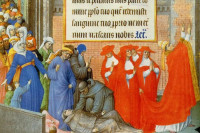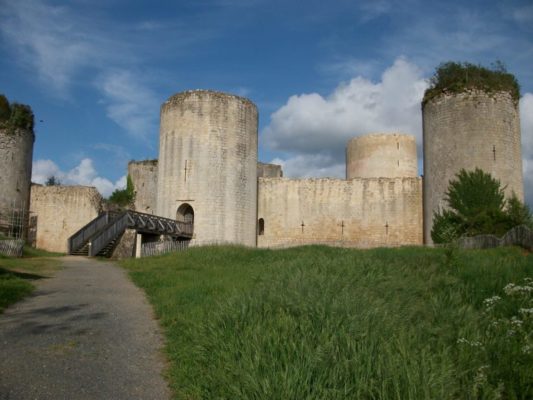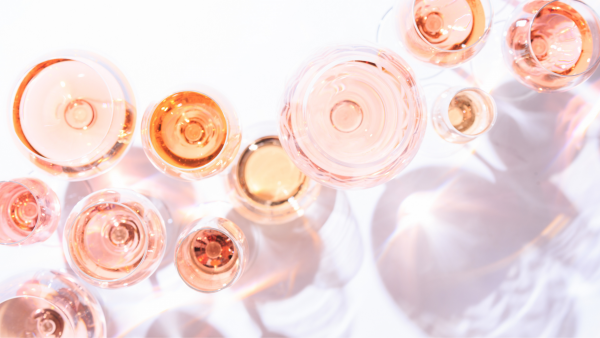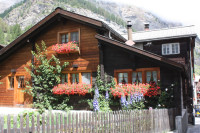Travel
A ride well worth it: stunning vistas and a fascinating old monastery make unforgettable lifetime memories
One year while staying outside of Le Grand Bornand in the Aravis mountains for a two week summer vacation with my parents, we decided to drive to a monastery called Le Reposoir.
We left our Alpine gîte located outside of the resort and started our drive toward our destination, 15 miles away.
After several days touring neighboring villages and larger Swiss cities and going on beautiful hikes, we were looking forward to a relaxing day.
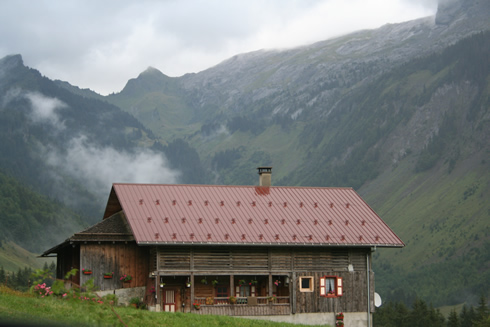
A gite in le Grand Bornand, France
Just before entering Le Grand Bornand, we passed some charming wooden chalets and many mountain pastures filled with large cows. I opened my window to hear the swinging sound of the huge bells they carried. These cows are famous for producing the mountain cheese, Reblochon. Since the 13th century, most of it is made in and around the village. It is recognizable for its large yellow cylinder shape and soft appearance.
La Colombière: a road with character
“Do you have the map? Do you know how to get there?,” asked suddenly my husband. My dad, who had often ridden his bike in the region, answered he would direct us. Paul took the wheel, driving very cautiously, taking each turn slowly. The windy road was large enough for one car but was actually made for two. Each time a car would drive by, I thought we would end up in the ravine. Luckily, French cars are tiny compared to American cars! I can only imagine how tourists must feel on this road, when sitting in high-rise tour buses!
My mother kept her eyes closed. I was speechless, my fingers grabbing the seat tightly and hoping this ride would quickly come to an end. Known as “Miss Itinerary”, that day, I wished I had planned to stay home in the gîte!
After seven miles driving on the road to the mountain pass La Colombière, we finally arrived at the top (5307 feet). We parked to enjoy the scenery. A couple donkeys and mountain goats stood on the side of the tiny road. The valley was green but rockier on the top. Many hikers were getting ready to leave for a long hike, with backpacks and polls in their hands. Bikers were checking their equipment before the upcoming descent.
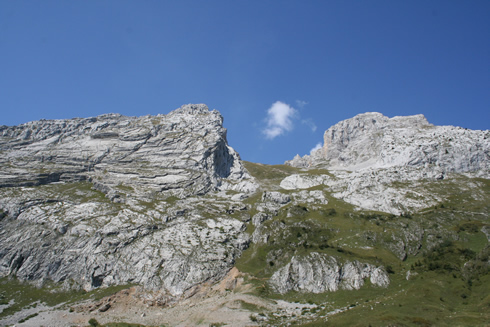
View near the Col de la Colombière after Le Grand Bornand
Back in our car, we slowly headed to Le Reposoir. The road did not get any better! “If only the French had railings to keep cars on the road in case one drives too close to the edge of the ravine!,” I kept on telling myself. “At least, it is not raining or foggy,” said my dad, who had not spoken a word for a while. It was the end of June and the road was dry. I read that this particular road is closed all winter through May. No wonder!!!
When we approached Le Reposoir, I thought of the bikers of the famous race the Tour de France, who over the last 49 years, have used it often.
Indescribable views
We left our car in the parking lot and walked toward the entrance. Would this stressful ride be all worth it? Would the place be as beautiful as on the pictures? Just one look at the convent and I had already forgotten how we had gotten there! The ride must have not been so awful after all! My parents looked amazed and my husband happy and relieved to be finally out of the car!
Indeed, the surroundings were quite picturesque. The evergreen trees, the pond, the alpine fields with the view of the highest summit of the Aravis mountain chain, La Pointe Percée (9026 feet) made it all worth it.
We even saw some some nearly extinct bearded vultures fly above us.
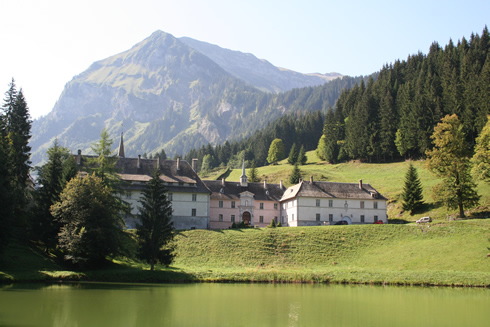
Le Reposoir moastery and pond, Haute Savoie
This wonderful place was so peaceful and favorable to meditation. I started to envy the nuns who live there. Why are the monasteries always built in the best places on earth? Why are these places so attractive to make you want to stay?
Should I have become a nun? The idea left my mind as fast as it had come, when I suddenly saw some snow at the top of the mountain. It made me realize how difficult it must be in the winter. It must feel so lonely without tourism and be so cold, when the snow comes and covers up the monastery and the surrounding fields for many months. I think I would die of despair. No, monastic life was not for me.
Before we entered the monastery, we sat under a large tree to have lunch, while waiting for it to reopen after the lunch break. The shade was quite enjoyable. I also took some time to read about the history of this magical site, which we were about to enter.
Back into the Past
�
Founded in the 12th century, in 1151, the monastery has only been a convent since 1932. Monasteries have existed since the end of the third century and many religious orders originating from monastic life. The most important ones are: the Carmelites, the Benedictines and the Carthusians.
The monastery was founded by a Carthusian monk, Jean d’Espagne, named because he originated from Spain. A follower of St Bruno, he came from the monastery of la Grande Chartreuse located near Grenoble not far away from Le Reposoir. It is the count of Chatillon, Aymon I de Faucigny, who often hunted there, who gave him the order to build it.
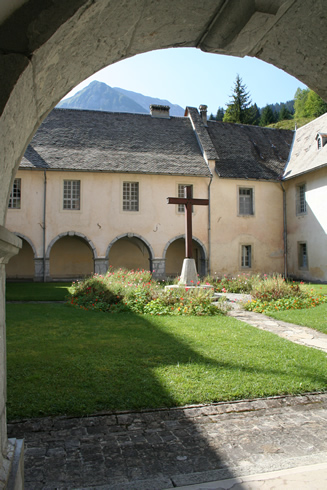
Reposoir inside cloister, Haute Savoy
When he arrived, Jean found an abandoned non-cultivated land on a small valley. The place was not safe, as wolves and bears and other wild animals roamed the area. Helped by other monks, he worked hard so that a monastery could be built. It was quite expensive, but they received funds from rich families. When not in prayers, the monks took part in agricultural work.
The monks named this place Le Reposoir (meaning an altar in French) because they found it peaceful. Jean d’Espagne is known to have said on his arrival: “Ici est mon reposoir” (Here is my altar). Jean died at a very young age not even a decade after his arrival at Le reposoir. He was 36 years old.
The monks lived there undisturbed for centuries. Unfortunately, they were forced to exile during the French Revolution; at that time, part of the place was also demolished. At the beginning of the 20th century, when the State and the Church separated, Le Reposoir became a hotel with little success. The Carthusians were forced to find another place to pray.
Luckily, it came into the hands of the right person at the right time. Alexandra di Rudini, whose father was an Italian prime minister, renovated it and later became a Carmelite herself. That’s how the monastery, which once belonged to the Carthusian monks, became the place of what today twenty Carmelite nuns call home. The founder of this order was also Spanish, St. Theresa of Avila.
Inside Le Reposoir
At opening time, we finally walked toward the large building. We entered the monastery by the front gate, very heavy and completely renovated in 1671.
The tour led us to the Gothic cloister, its tiny square inner garden surrounded with arches and to its chapel with beautiful stain-glass windows. We listened to a 20-minute audio film retracing the history of Le Reposoir and monastic life. The nuns get up early to pray and between prayers they make handy crafts (pottery, broidery, knitting), which they sell in their store. They also sell jams, honey and various religious books.
From time to time, like by magic, we could catch a sight of the nuns, kneeling in chapels. I was amazed to see how young they were. The one, who sold us some crafts, was a novice still wearing a white veil.
After a short walk around the lake, we all left with a smile on our face. We had for a day found a place to unwind, a place that we would not forget easily. Days like this are greatly appreciated and needed to recharge our “batteries” in a world so noisy and hectic.
I came to finally understand what the sisters have found at Le Reposoir: SERENITY.
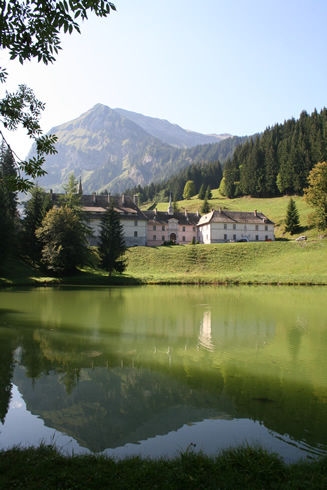
Pointe Percée reflecting into the pond, Le Reposoir
You want to go to Le Reposoir
How to get to Le Reposoir:
The nearest International airport is in Geneva. Car rentals are available at the airport.
The best is to stay in Le Grand Bornand, 31 miles from Geneva. Take the A40 highway (autoroute blanche) and take exit 16 Bonneville and then drive another 14 miles following the sign Stations des Aravis.
To go to Le Reposoir, take the road D4 from Le Grand-Bornand, heading toward Col de la colombière.
Where to stay and dine:
Best Western
Chalet les Saytels, Le Village Mt Blanc in Le Grand Bornand
Call 33(0) 4 50 02 20 16
Check out the website
This beautiful old chalet has views of the Mountain chain Aravis and is just one block away from the village. Doubles start at $153 per night.
Hotel La Croix St Maurice
Famille Missillier in Le Grand Bornand
Call 0033(0) 4 50 02 20 05
For more info write to info@hotel-lacroixstmaurice.com. The hotel is in the village and has friendly staff. The rooms are nice and comfortable.
For renting gîtes, call the office of tourisme 0033(0) 4 50 02 78 00 or write to infos@legrandbornand.com.
Restaurant L’ourson
27 Passage du Mont Blanc in La Clusaz
To reserve call 033(0) 4 50 32 99.
Excellent tasty traditional and regional cooking. (Gaultmillau 2007)
Other:
Local Market Le Grand-Bornand has an interesting summer program. Among them are: The Wednesday morning Reblochon’s market is a plus.
Information: Contact the tourist office (0) 4.50 02 78 00
Check out the Grand Bornand website.
For more info about le Reposoir, write to the Office of Tourism of Le Reposoir, Syndicat d’initiative, Pralong, 74950 Le Reposoir.
Call 033(0) 4 50 98 18 01 or e-mail si.lereposoir@wanadoo.fr.

